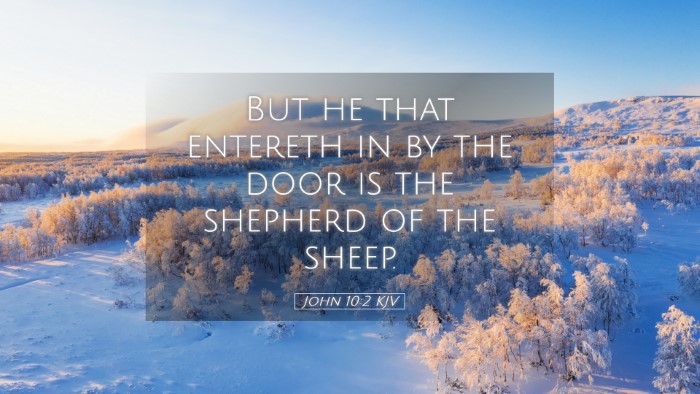Commentary on John 10:2
Verse Reference: John 10:2
“But he who enters by the door is the shepherd of the sheep.”
Introduction
The verse in question is part of Jesus’ discourse on the Good Shepherd, which carries profound implications for understanding His identity and mission as well as the nature of His followers. This commentary synthesizes insights from esteemed public domain theologians such as Matthew Henry, Albert Barnes, and Adam Clarke, providing a comprehensive examination of John 10:2.
Exegesis of John 10:2
At the outset, it is essential to contextualize this verse within the broader narrative of John 10. Jesus uses the metaphor of the shepherd and the sheep to elucidate the relationship between Himself and His followers, contrasting this with the behaviors of thieves and robbers.
Understanding the Door
Henry observes that the “door” symbolizes the legitimate access point to the fold, emphasizing that only the true shepherd can enter through it, representing an authoritative entrance. This stands in stark contrast to other figures who seek to enter by other means, which signals deceit and ulterior motives. By entering through the door, the shepherd affirms his legitimate claim over the sheep.
The Role of the Shepherd
Barnes expounds on the notion of the shepherd as one who has care and authority over the sheep. The shepherd’s role extends beyond mere oversight; it encompasses protection and guidance. The shepherd demonstrates a deep personal investment in the welfare of the sheep, often at great personal sacrifice. This relational aspect invites deeper reflection on the nature of Christ’s leadership.
The Implication for the Sheep
Clarke emphasizes that the sheep recognize the voice of their shepherd and follow him because of the inherent trust established through a personal relationship. Jesus here hints at the intimate knowledge that He shares with those who follow Him, starkly contrasted with the relationship that the sheep would have with impostors who do not enter through the door. This passage reinforces the need for discernment among the followers of Christ, urging believers to remain attuned to His voice amid competing voices.
Theological Implications
John 10:2 encapsulates significant theological themes regarding authority, access, and care within Christian doctrine. The divine authority of Christ as the Good Shepherd is underscored; He possesses the intrinsic right to lead, guide, and protect.
Authority of Christ
The authority of Christ, highlighted by His entry through the door, is a critical point of reflection. As Barnes notes, this power and legitimacy are paramount, setting Him apart from other figures claiming leadership. The implication here is dual-faceted: it reassures the faithful of Christ's rightful claim while also serving as a challenge to false leaders.
Access to the Fold
The concept of access to the fold, symbolized by the door, merits deeper meditation. For believers, this symbolizes the only way to true community and safety within the flock. Henry notes that this aligns with Jesus’ declaration in John 14:6, where He refers to Himself as “the way, the truth, and the life.” The shepherd’s role thus serves to affirm the uniqueness of Christ in providing the only means of access to God.
Care and Sacrifice
Finally, the role of the shepherd encompasses profound care and sacrifice. Clarke reflects on the nature of shepherding, which often entails vulnerability and the willingness to confront threats for the sake of the flock. This foreshadows Jesus’ ultimate sacrifice on the cross, illustrating the depth of commitment He extends to His followers. Herein lies a call for pastors and leaders to embody these qualities in their ministry, mirroring Christ’s sacrificial love.
Practical Applications
- Listening for the Shepherd's Voice: Believers are encouraged to cultivate a discernment that allows them to recognize and respond to the voice of Christ amidst cultural and societal distractions.
- Understanding Leadership: Pastors and spiritual leaders are called to model the characteristics of Christ as the Good Shepherd, prioritizing care, guidance, and protection over self-interest.
- Community Within the Fold: The church community should strive to maintain unity and mutual care, reflecting the relationship between the shepherd and the sheep.
- Embracing Vulnerability: Just as the shepherd faces risks for the flock, church leaders must be willing to invest personally in the lives of their congregants, offering guidance and support.
Conclusion
In John 10:2, the metaphoric language used by Jesus speaks powerfully to His identity and the nature of the pastoral relationship with His followers. The insights of Henry, Barnes, and Clarke reinforce the understanding that Christ as the true shepherd offers legitimate, loving leadership that demands a corresponding response of loyalty and recognition from His sheep.


